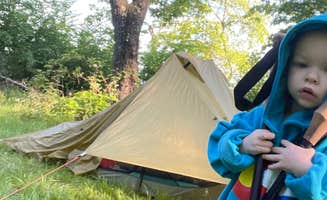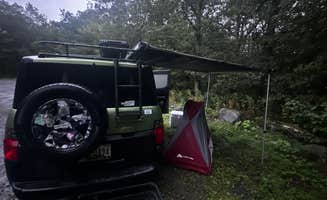Dispersed camping near Frenchtown, New Jersey spans across state lines into Pennsylvania, with opportunities primarily concentrated along the Appalachian Trail corridor. The region sits at the edge of the Delaware Water Gap, featuring mixed hardwood forests with elevations ranging from 300 to 1600 feet. Winter camping requires additional preparation as temperatures can drop below freezing from November through March.
What to do
Explore rocky overlooks: The Bake Oven Knob area provides access to notable viewpoints along Blue Mountain ridge. According to visitor Dani T., "The hike to the overlook is really lovely; short and rocky," making it accessible for day hikers and overnight campers alike.
Hike through marshlands: Thunder Swamp Trailhead serves as a gateway to diverse ecosystems. As Jason R. notes, campers can go "down Saw Creek trail to a marsh," allowing for exploration of wetland habitats not commonly associated with the region's predominantly forested terrain.
Hammock camping: The terrain at several sites better accommodates hammocks than tent pads. At the Appalachian Trail Designated Backpacker Campsite 2, Renee Z. found that while the area is "a little on the small and sloped side for tent camping," it was "a great place for hammock" camping, suggesting visitors consider alternative sleeping arrangements.
What campers like
Bear protection infrastructure: Several camping areas include storage facilities for food safety. Katharine T. observed the Appalachian Trail Designated Backpacker Campsite 2 was "well maintained with bear boxes provided," reducing wildlife concerns for overnight stays.
Flexibility for social preferences: Campsites offer various configurations for both group and solitary experiences. Katharine T. appreciated that "there's plenty of space. We camped nearer to others but there are secluded spots too," providing options for different camping styles at the same location.
Overnight parking tolerance: For those planning backcountry access, Benjamin H. found that Thunder Swamp Trailhead offers "a gravel parking lot" with "plenty of shade" where "no one bothered me," suggesting reasonable overnight parking options for hikers.
What you should know
Water scarcity: Water sources require planning and additional hiking. Renee Z. cautions that at Appalachian Trail Designated Backpacker Campsite 2, "there's no water nearby," and suggests visitors either "stock up on water at Dunnfield creek natural area, or wait until Sunfish pond."
Strict camping regulations: Many areas have designated camping zones with limited alternatives. As Renee Z. discovered, "as you enter the Worthington State Forest there are signs and hand painted maps indicating that this is the only place you can sleep in the forest."
Unmarked sites: Some designated camping areas lack clear signage. Renee Z. noted that the Appalachian Trail site "is unmarked when you come to it, but it's the only pretty obvious camping spot on the trail so it's not hard to find."
Tips for camping with families
Plan for longer water carries: Families need to calculate higher water requirements without nearby sources. At Appalachian Trail Designated Backpacker Campsite 2, Katharine T. mentions "No Water (nearest is sunfish pond - easy hike about a 1 mile round trip)," requiring families to carry sufficient supplies.
Consider vehicle access points: For easier family logistics, certain trailheads permit vehicle proximity. Bake Oven Knob provides options where, according to Dani T., "There are two large lots. You can park and sleep, or hike in and find a place for a tent."
Evaluate campsite terrain: Many sites feature uneven ground requiring careful tent placement. Renee Z. rated Appalachian Trail Designated Backpacker Campsite 2 four stars because "it's a little on the small and sloped side for tent camping," suggesting families select sites carefully.
Tips from RVers
Overnight parking limitations: Small vans may find suitable overnight options at certain trailheads. Dani T. reports, "I've overnighted in my van here [Bake Oven Knob] a bunch, no problems," though this applies primarily to smaller vehicles rather than larger RVs.
Access road considerations: Roads leading to trailheads may present challenges for larger vehicles. The parking areas tend to be "gravel" lots as Benjamin H. described at Thunder Swamp Trailhead, requiring careful navigation during wet conditions.



